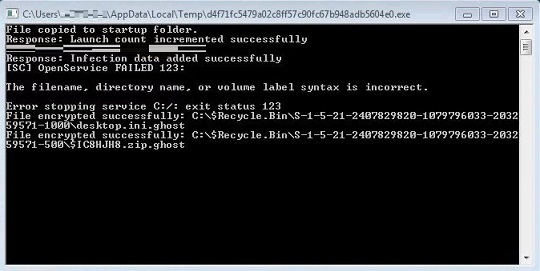Ransom.Win64.GHOSTLOCKER.THKBOBC
UDS:Trojan-Ransom.Win32.Crypren.ajpw (KASPERSKY); Ransom:Win64/GhostLocker.YAA!MTB (MICROSOFT)
Windows


Threat Type: Ransomware
Destructiveness: No
Encrypted: No
In the wild: Yes
OVERVIEW
Downloaded from the Internet, Dropped by other malware
This Ransomware arrives on a system as a file dropped by other malware or as a file downloaded unknowingly by users when visiting malicious sites.
It connects to certain websites to send and receive information.
It encrypts files found in specific folders. It drops files as ransom note. It avoids encrypting files with the following file extensions.
TECHNICAL DETAILS
7,333,376 bytes
EXE
No
20 Nov 2023
Connects to URLs/IPs, Drops files, Displays windows, Encrypts files
Arrival Details
This Ransomware arrives on a system as a file dropped by other malware or as a file downloaded unknowingly by users when visiting malicious sites.
Installation
This Ransomware adds the following processes:
- sc stop C:\
- cmd start /c %Desktop%\RansomNote.html
(Note: %Desktop% is the current user's desktop, which is usually C:\Documents and Settings\{User Name}\Desktop on Windows 2000(32-bit), XP, and Server 2003(32-bit), or C:\Users\{user name}\Desktop on Windows Vista, 7, 8, 8.1, 2008(64-bit), 2012(64-bit) and 10(64-bit).)
Autostart Technique
This Ransomware drops the following file(s) in the Windows User Startup folder to enable its automatic execution at every system startup:
- %User Startup%\{Malware Filename and Extension} → copy of itself
(Note: %User Startup% is the current user's Startup folder, which is usually C:\Windows\Profiles\{user name}\Start Menu\Programs\Startup on Windows 98 and ME, C:\WINNT\Profiles\{user name}\Start Menu\Programs\Startup on Windows NT, C:\Documents and Settings\{User name}\Start Menu\Programs\Startup on Windows 2003(32-bit), XP and 2000(32-bit), or C:\Users\{user name}\AppData\Roaming\Microsoft\Windows\Start Menu\Programs\Startup on Windows Vista, 7, 8, 8.1, 2008(64-bit), 2012(64-bit), 10(64-bit).)
Other Details
This Ransomware connects to the following website to send and receive information:
- using HTTP POST:
- http://{BLOCKED}.{BLOCKED}.{BLOCKED}.246/incrementLaunch
Information sent:- username : {Hard-coded username value}
- http://{BLOCKED}.{BLOCKED}.{BLOCKED}.246/addInfection
Information sent:- id : {Generated ID}
- identifier : {Hard-coded identifier value}
- infection_date : {Date executed}
- ip : "your_ip" → Hard-coded value
- key : {Generated Key}
- ransom_amount : "0.00138" → Hard-coded value
- status : "your_status" → Hard-coded value
- username : {Hard-coded username value}
- http://{BLOCKED}.{BLOCKED}.{BLOCKED}.246/incrementLaunch
- It prints the response from the C2 to the commandline.
- If no response is received, execution is terminated.
It does the following:
- It uploads files and its full file path information to the C2.
- File extensions:
- .doc
- .docx
- .xls
- .xlsx
- Using HTTP POST:
- http://{BLOCKED}.{BLOCKED}.{BLOCKED}.246/upload
- Information sent:
- {Hard-coded username}
- {Generated ID}
- {Full File Path}
- {File Contents}
- File extensions:
- It displays a console that logs the status of the execution and encryption.

Ransomware Routine
This Ransomware encrypts files found in the following folders:
- C:\
It avoids encrypting files found in the following folders:
- C:\Windows
It appends the following extension to the file name of the encrypted files:
- .ghost
It drops the following file(s) as ransom note:
- %Desktop%\RansomNote.html

It avoids encrypting files with the following file extensions:
- .ghost
- .doc
- .docx
- .xls
- .xlsx
SOLUTION
9.800
18.830.05
20 Nov 2023
18.831.00
21 Nov 2023
Step 1
Trend Micro Predictive Machine Learning detects and blocks malware at the first sign of its existence, before it executes on your system. When enabled, your Trend Micro product detects this malware under the following machine learning name:
-
BKDR.Win32.TRX.XXPE50FFF075E0002
Step 2
Before doing any scans, Windows 7, Windows 8, Windows 8.1, and Windows 10 users must disable System Restore to allow full scanning of their computers.
Step 3
Note that not all files, folders, and registry keys and entries are installed on your computer during this malware's/spyware's/grayware's execution. This may be due to incomplete installation or other operating system conditions. If you do not find the same files/folders/registry information, please proceed to the next step.
Step 4
Search and delete these files
- %User Startup%\{Malware Filename and Extension}
- %Desktop%\RansomNote.html
Step 5
Scan your computer with your Trend Micro product to delete files detected as Ransom.Win64.GHOSTLOCKER.THKBOBC. If the detected files have already been cleaned, deleted, or quarantined by your Trend Micro product, no further step is required. You may opt to simply delete the quarantined files. Please check the following Trend Micro Support pages for more information:
Step 6
Restore encrypted files from backup.
Did this description help? Tell us how we did.

